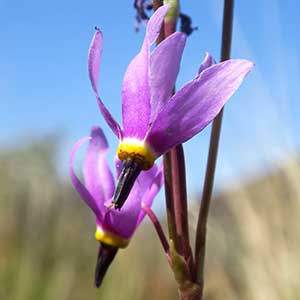Dodecatheon conjugens
Dodecatheon jeffreyi
Bonneville shooting star, desert shootingstar, slim-pod shooting star
Jeffrey's shooting star, Sierra shootingstar, tall mountain shooting star
not obvious at anthesis;
roots whitish;
bulblets absent.
not obvious at anthesis or usually horizontal, relatively short and thick or elongate and slender;
roots usually white;
bulblets absent.
3–13(–18) × 0.7–2.5(–4) cm;
petiole slender (at least proximally);
blade narrowly oblanceolate to spatulate or obovate, base usually not decurrent onto stem, usually abruptly tapering to petiole, margins entire, surfaces glabrous or glandular-puberulent.
(2.5–)7–40(–53) × (0.5–)1–6(–7.5) cm;
petiole winged;
blade narrowly oblanceolate or oblanceolate to spatulate, base decurrent onto stem, usually gradually tapering to petiole, margins entire or crenate to serrulate, surfaces glabrous or glandular-pubescent.
1–7(–10)-flowered;
bracts lanceolate to broadly lanceolate, 3–10 mm, glandular-puberulent.
3–20-flowered;
bracts lanceolate to broadly lanceolate, 3–17 mm, glandular-pubescent.
1–5 cm, glabrous or glandular-puberulent.
2–7 cm, usually glandular-pubescent, rarely glabrous.
calyx light green to yellowish, sometimes finely purple-speckled or -dotted, 5–12 mm, glabrous or glandular-puberulent, tube 2–6 mm, lobes 5, 3–7 mm;
corolla tube yellowish with purplish red, thin, wavy ring, lobes 5, usually magenta, sometimes white, 7–25(–35) mm;
filaments usually distinct, yellowish or dark maroon, 0.5–1.5 mm, rarely partially connate and tube 0.5–1.5 × 1.5–5 mm;
anthers 5–9 mm;
pollen sacs usually maroon or yellow, sometimes yellowish and speckled maroon, rarely with reddish purple to purple speckles, connective usually maroon, sometimes yellowish or light blue to whitish, transversely rugose;
stigma not enlarged compared to style.
calyx green, 7–12(–15) mm, usually glandular-pubescent, rarely glabrous, tube 2–4 mm, lobes 4–5, 4.5–8(–12) mm;
corolla tube cream or (rarely) yellow with reddish to purplish, thin to thick, often wavy ring, ring rarely absent, lobes 4–5, magenta to lavender or light yellow to whitish, 10–25(–27) mm;
filaments distinct or partially connate, dark maroon to black, usually 1–1.5 mm;
anthers 6.5–11 mm, (apex truncate to obtuse);
pollen sacs yellow or maroon, connective purplish, transversely rugose;
stigma enlarged, diam. no more than 2 times style.
tan, often striped with purple, usually operculate, rarely valvate, cylindric-ovoid, 8–17(–22) × 4–6(–8) mm, glabrous;
walls thin, pliable.
yellowish tan to reddish brown, operculate or sometimes valvate, sometimes both on same plant, ovoid, 7–11(–15) × 4.5–7(–10) mm, glabrous or teeth sometimes sparsely glandular-puberulent;
walls thin, pliable.
without membrane along edges.
with thin membrane along edges.
= 44.
= 42, 44, 66, 86.
Dodecatheon conjugens
Dodecatheon jeffreyi
Varieties 2 (2 in the flora).
Both Dodecatheon conjugens and D. poeticum occur in proximity in the Columbia River gorge. Some specimens here assigned to var. conjugens may have scattered, minute glands on the pedicels that might indicate past hybridization with D. poeticum (e.g., G. N. Jones 6286, ORE; R. R. Halse 3790, OSC, WTU). Dodecatheon poeticum is densely glandular not only on the pedicels, but also on the calyx and scape. The type of minute glandular puberulence seen on var. conjugens found along the Columbia River west of The Dalles is somewhat similar to that seen on var. viscidum in western Montana and Canada. Some plants referred here to D. conjugens have slightly connate filaments that may indicate some intergradation with D. pulchellum var. pulchellum. This suggestion is supported by the tendency in the same plants to have narrower leaves.
Some newly emerged flowers tend to have connectives that are less rugose than normal. This is particularly true of some populations in southern Alberta and, to a lesser degree, in Saskatchewan.
(Discussion copyrighted by Flora of North America; reprinted with permission.)
Dodecatheon jeffreyi is found in montane places in the Sierra Nevada of California and western Nevada and on the northern coastal ranges and Siskiyou Mountains of northern California and southwestern Oregon. It occurs in the Cascade Ranges of Oregon, Washington, and British Columbia northward to the Kenai Peninsula region of south-central Alaska, often near the coast and especially on the off-shore islands. It is also widely scattered in the mountains of northeastern Oregon, central and northern Idaho, and western Montana, with isolated stations on the Olympic Peninsula of Washington. A single collection (J. Major 2927, GTNP) from Moose Basin, Grand Teton National Park, is the only record from Wyoming.
Dodecatheon jeffreyi is usually readily recognized; in portions of California, the delimitation of it from both D. alpinum and D. redolens can be somewhat arbitrary. Whether this is a breakdown of species boundaries due to hybridization or a shift in their respective morphologies due to overlapping ecological settings is uncertain. In some instances, intermediate plants seem to occur in areas where two of the species occur in proximity. In general, the corolla tube of D. jeffreyi is white except near the ring, where it is yellow. In D. redolens, the entire corolla tube is yellow.
This species is known universally as Dodecatheon jeffreyi, although it was named a year earlier as D. jeffreyanum K. Koch. To avoid the introduction of a name that has never been used for this widespread and sometimes cultivated plant, D. jeffreyanum has been proposed for rejection (J. F. Veldkamp et al. 2008).
(Discussion copyrighted by Flora of North America; reprinted with permission.)
1. Leaf blades, scapes, and pedicels glabrous. | var. conjugens |
1. Leaf blades, scapes proximally, and pedicels usually glandular-puberulent. | var. viscidum |
- Local floras:
BC,
CA,
OR,
WA
- Local Web sites:
CalFlora,
CalPhotos,
Flora NW,
PNW Herbaria,
Turner Photog.
WildflowerSearch
iNaturalist (observations)
USDA Plants Database
- LBJ Wildflower Center
- SEINet
- Plants of the World Online
- Encyclopedia of Life
- Wikipedia
- Google Image Search
- Local floras:
BC,
CA,
OR,
WA
- Local Web sites:
CalFlora,
CalPhotos,
Flora NW,
PNW Herbaria,
Turner Photog.
WildflowerSearch
iNaturalist (observations)
USDA Plants Database
- LBJ Wildflower Center
- SEINet
- Plants of the World Online
- Encyclopedia of Life
- Wikipedia
- Google Image Search


